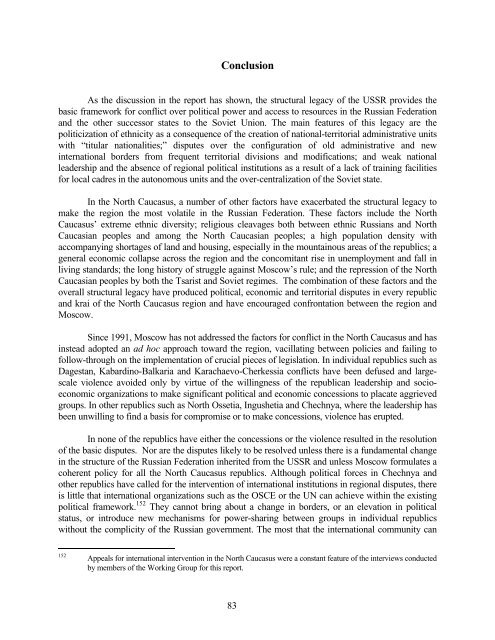RUSSIA'S TINDERBOX - Belfer Center for Science and International ...
RUSSIA'S TINDERBOX - Belfer Center for Science and International ...
RUSSIA'S TINDERBOX - Belfer Center for Science and International ...
Create successful ePaper yourself
Turn your PDF publications into a flip-book with our unique Google optimized e-Paper software.
Conclusion<br />
As the discussion in the report has shown, the structural legacy of the USSR provides the<br />
basic framework <strong>for</strong> conflict over political power <strong>and</strong> access to resources in the Russian Federation<br />
<strong>and</strong> the other successor states to the Soviet Union. The main features of this legacy are the<br />
politicization of ethnicity as a consequence of the creation of national-territorial administrative units<br />
with “titular nationalities;” disputes over the configuration of old administrative <strong>and</strong> new<br />
international borders from frequent territorial divisions <strong>and</strong> modifications; <strong>and</strong> weak national<br />
leadership <strong>and</strong> the absence of regional political institutions as a result of a lack of training facilities<br />
<strong>for</strong> local cadres in the autonomous units <strong>and</strong> the over-centralization of the Soviet state.<br />
In the North Caucasus, a number of other factors have exacerbated the structural legacy to<br />
make the region the most volatile in the Russian Federation. These factors include the North<br />
Caucasus’ extreme ethnic diversity; religious cleavages both between ethnic Russians <strong>and</strong> North<br />
Caucasian peoples <strong>and</strong> among the North Caucasian peoples; a high population density with<br />
accompanying shortages of l<strong>and</strong> <strong>and</strong> housing, especially in the mountainous areas of the republics; a<br />
general economic collapse across the region <strong>and</strong> the concomitant rise in unemployment <strong>and</strong> fall in<br />
living st<strong>and</strong>ards; the long history of struggle against Moscow’s rule; <strong>and</strong> the repression of the North<br />
Caucasian peoples by both the Tsarist <strong>and</strong> Soviet regimes. The combination of these factors <strong>and</strong> the<br />
overall structural legacy have produced political, economic <strong>and</strong> territorial disputes in every republic<br />
<strong>and</strong> krai of the North Caucasus region <strong>and</strong> have encouraged confrontation between the region <strong>and</strong><br />
Moscow.<br />
Since 1991, Moscow has not addressed the factors <strong>for</strong> conflict in the North Caucasus <strong>and</strong> has<br />
instead adopted an ad hoc approach toward the region, vacillating between policies <strong>and</strong> failing to<br />
follow-through on the implementation of crucial pieces of legislation. In individual republics such as<br />
Dagestan, Kabardino-Balkaria <strong>and</strong> Karachaevo-Cherkessia conflicts have been defused <strong>and</strong> largescale<br />
violence avoided only by virtue of the willingness of the republican leadership <strong>and</strong> socioeconomic<br />
organizations to make significant political <strong>and</strong> economic concessions to placate aggrieved<br />
groups. In other republics such as North Ossetia, Ingushetia <strong>and</strong> Chechnya, where the leadership has<br />
been unwilling to find a basis <strong>for</strong> compromise or to make concessions, violence has erupted.<br />
In none of the republics have either the concessions or the violence resulted in the resolution<br />
of the basic disputes. Nor are the disputes likely to be resolved unless there is a fundamental change<br />
in the structure of the Russian Federation inherited from the USSR <strong>and</strong> unless Moscow <strong>for</strong>mulates a<br />
coherent policy <strong>for</strong> all the North Caucasus republics. Although political <strong>for</strong>ces in Chechnya <strong>and</strong><br />
other republics have called <strong>for</strong> the intervention of international institutions in regional disputes, there<br />
is little that international organizations such as the OSCE or the UN can achieve within the existing<br />
political framework. 152 They cannot bring about a change in borders, or an elevation in political<br />
status, or introduce new mechanisms <strong>for</strong> power-sharing between groups in individual republics<br />
without the complicity of the Russian government. The most that the international community can<br />
152 Appeals <strong>for</strong> international intervention in the North Caucasus were a constant feature of the interviews conducted<br />
by members of the Working Group <strong>for</strong> this report.<br />
83
















